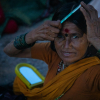The three-day festival of Gaurī Vrata is celebrated in the entire Maharashtra with great devotion and enthusiasm. In the two geographical regions of the state, demarcated as Deccan and coastal, the vrata is celebrated in ways different from each other. In the coastal region of Maharashtra, Goddess Jyeṣṭhā is worshipped in the form of pebbles, herbs, pictures, terracotta or metal facemasks. On the other hand, in the Deccan region of Maharashtra, Gaurīs or Mahālakṣmīs are worshipped in the form of terracotta or metal facemasks only. The rituals and customs are found in a very elaborate form in the Deccan part of Maharashtra. The three-day rituals and customs can be grouped into the following categories for the purpose of understanding.
Preparation for the Rituals
Deccan Maharashtra: Those who perform the vrata have special facemasks for worship. One among these is called Jyeṣṭhā and the other is called Kaniṣṭhā, after the two goddesses. Along with facemasks, other materials which are needed for making idols are also carefully kept by people; it includes body structures, busts, drapery, jewellery, etc. All these materials are neatly packed and kept at home. On the day or day before the festival, materials are taken out and dusting is done—usually by a responsible and elderly person. The place where the goddesses are to be installed is prepared in the central part of the home. Care is taken while preparing the place of installation of Gaurī, making sure that she would not be facing south. The body and bust of the idols are draped with the sari. Saris are changed every year or after an interval of a decided year as per the wish of the devotee. The busts draped with sari and decorated with jewellery are kept at the puja place. A zigzag line of wheat, called ‘chauka’, is made around the Gaurīs. Additionally, all the puja materials—such as flowers, herbs and kumkum—are collected together.
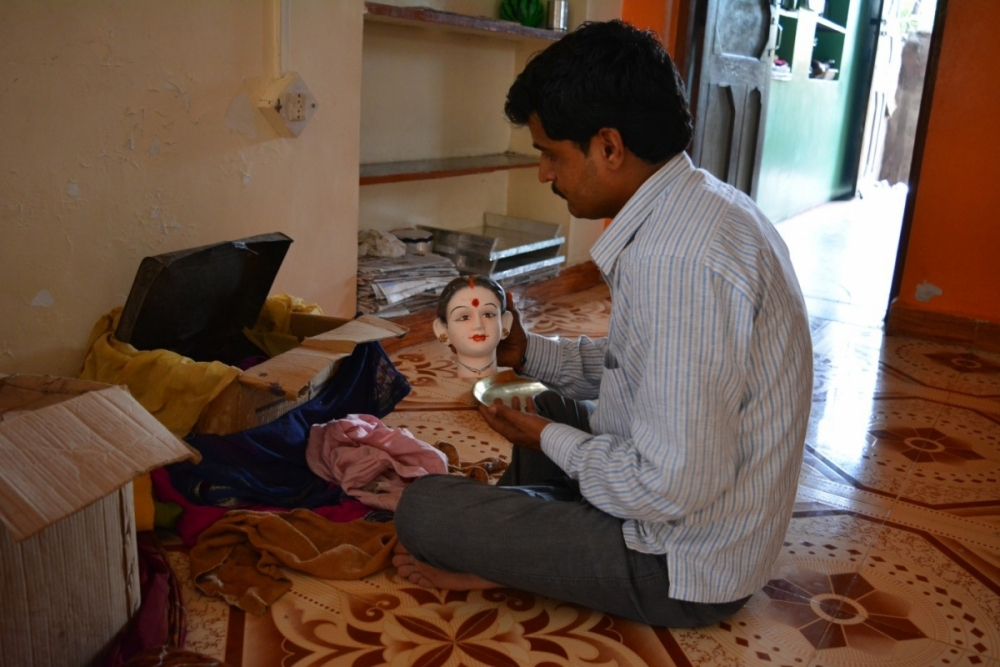
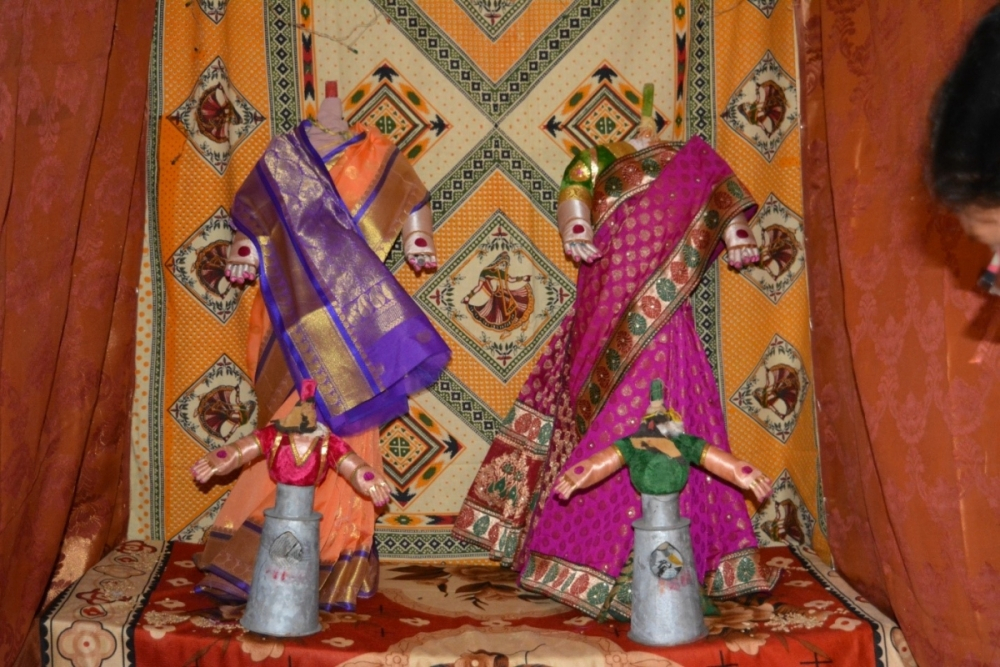
Coastal Maharashtra: In the coastal areas of Maharashtra, Goddess Jyeṣṭhā is worshipped mainly in the form of pebbles or herbs. All the puja materials—such as flowers, herbs and kumkum—are collected together. Those who have only one facemask follow the Deccan style of preparation.
Invocation Ceremony
Deccan Maharashtra: For the invocation, facemasks are kept in front of the sanctum of the house and worshipped. The woman of the house takes the facemasks out after covering the head of the masks with pieces of fabric. As they re-enter the house, at the threshold, the woman and facemasks are treated with welcome rituals which include washing the feet of the woman with milk and water; kumkum and aukṣaṇa are then applied on the woman and the facemasks. The facemasks are then taken around the interiors of the house as devotees recite the prayer: ‘goddesses arrived with prosperity’. The facemasks are kept on decorated busts and an offering of rice (akṣata) is made; it is believed that divinity appears in them.
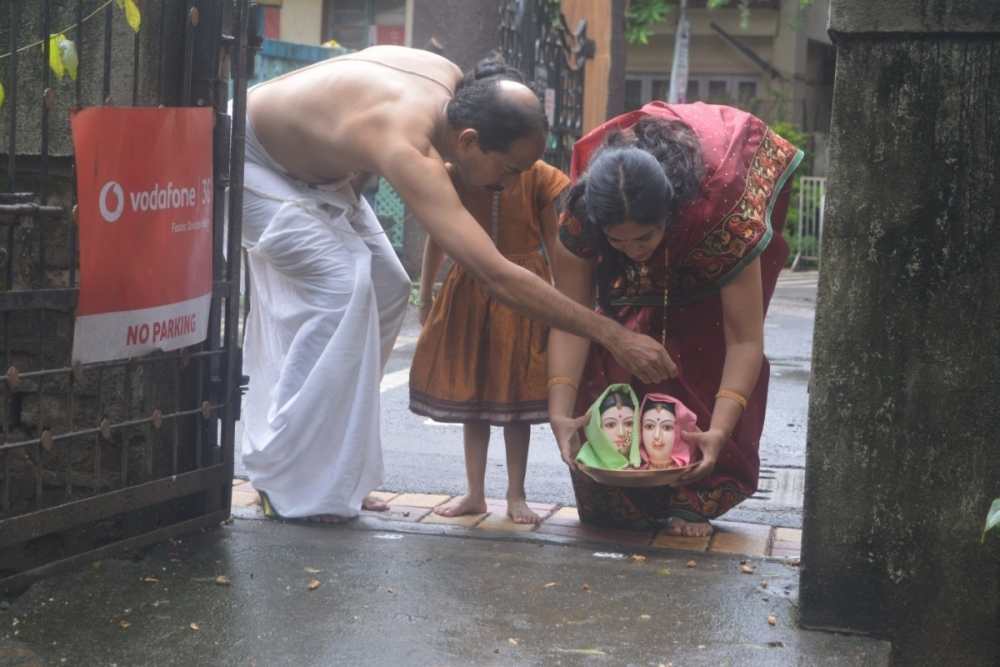
Coastal Maharashtra: Here, pebbles—two, five or seven in number—or local herbs and flowering plants are brought into the house from a water source such as the well, tank, river, pond, etc. The ritual starts with offerings made to the pebbles or herbs while they are still in the water source. The woman who is the carrier of the mask enters the house without talking; she is flanked by the sound of the ritual bell and people reciting prayers for prosperity as in the Deccan part of Maharashtra. Goddesses are then taken to each corner of the house and, finally, herbs or pebbles are placed at the sanctum of the house for worshipping.
Worship of Gaurī
Deccan Maharashtra: On the first day after installation, the goddess is worshipped followed by ārati.[1] However, the main worship takes place on the second day. On the second day, elaborate worship of both the goddesses is done. Some people invite a brāhmaṇa for worship while others perform it themselves. Puja is done mainly with ṣoḍaśopacāra,[2] i.e., with 16 measures of worship. After the puja, an ārati takes place in which 16 lamps are waved around the goddesses. Till today, the tradition of gathering everyone at home on the second day of worship is followed.
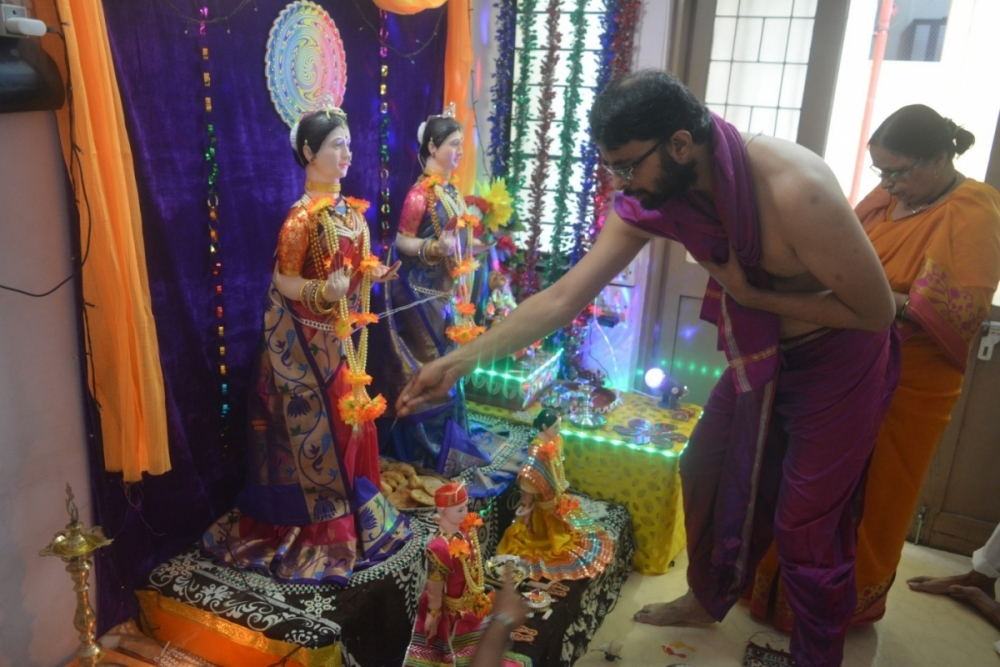
Coastal Maharashtra: As in the Deccan, no separate worship takes place here on the first day. On the second day, the goddess is worshipped along with other deities. Unlike the Deccan part of Maharashtra, the pattern of worship here is very simple.
Food Offerings to Gauri
Deccan Maharashtra: Elaborate worship on the second day is concluded with food offerings to goddesses. According to a set of beliefs, goddesses visit their maiden home during this festival. Hence, people treat them like their daughters and fulfill their wishes. A variety of foods is prepared on the second day; usually, according to the set rituals, 16 food items are offered.
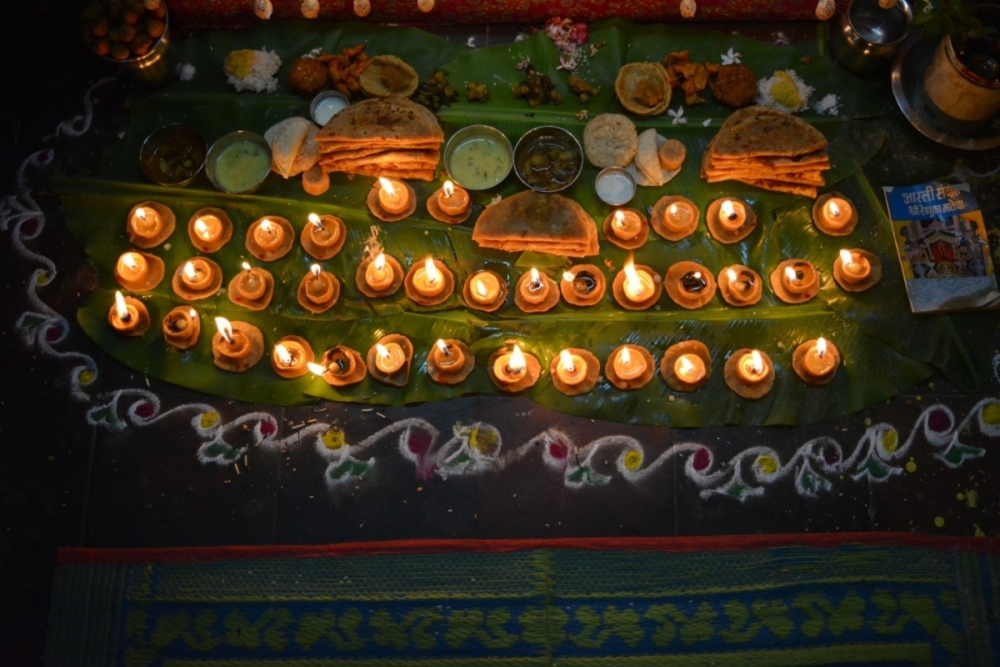
Coastal Maharashtra: In coastal Maharashtra, on the first day of the ritual, leafy vegetables and bhākari (roṭī prepared from rice or jowar flour) are offered to the goddess. On the second day, mainly ghāvanghāṭala (pancakes made from rice flour) are offered with regular food. On the third day, pāyasam or khīra is offered to the goddess. Unlike the Deccan, in the coastal region, different food items are offered on all three days.
Immersion Ceremony
Deccan Maharashtra: On the evening of the third day, a symbolic immersion takes place. After the puja and ārati, curd and rice are offered to the goddesses as farewell food followed by the removal of facemasks. Some people take facemasks to the water bodies and sprinkle some water on them as an act of symbolic immersion and take the masks back home. Finally, everything is wrapped up and kept neatly for the coming year.
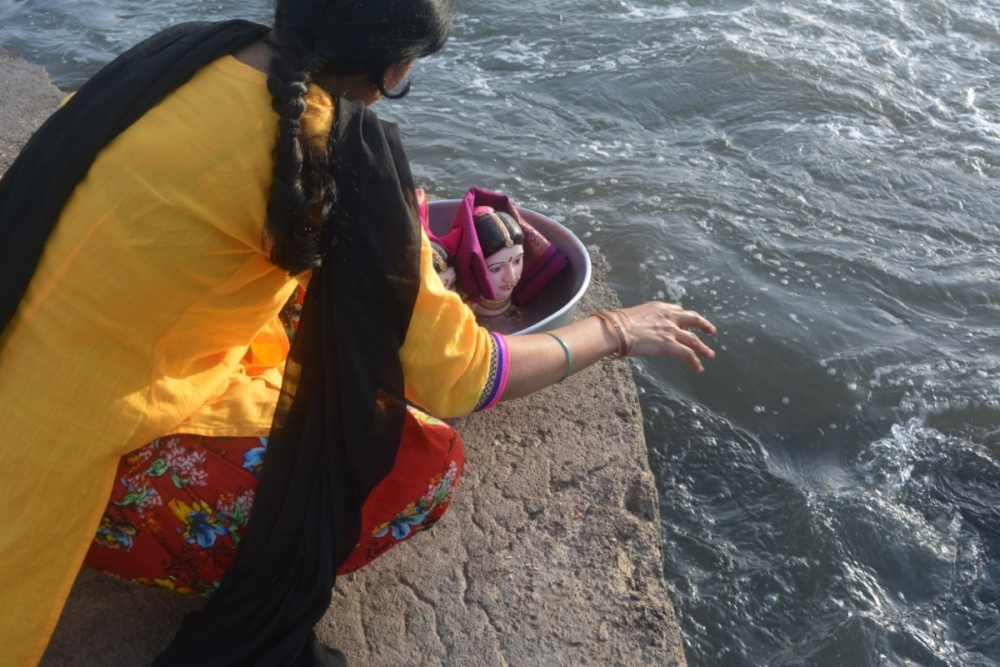
Coastal Maharashtra: In coastal Maharashtra, pebbles or plants are immersed in water on the third day. Here, too, curd and rice are offered to the goddess as farewell food before the immersion. Proper immersion takes place in coastal Maharashtra unlike the their Deccan counterpart.
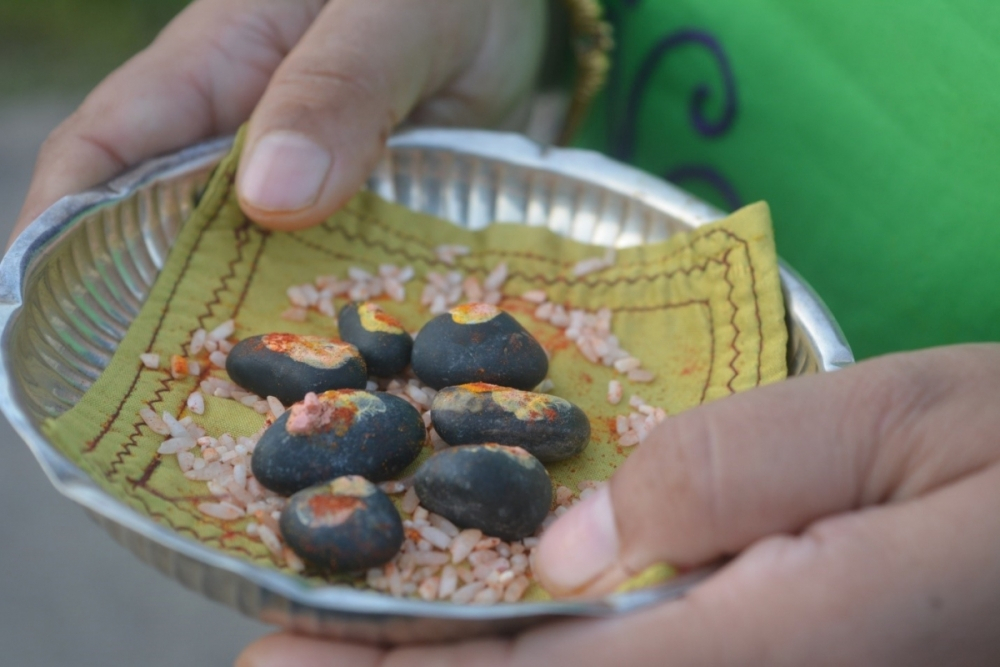
Notes
[1] Ārati is a set of devotional songs which are sung at the end of worship while waving the lighted lamp around the God.
[2] Worship with ṣoḍaśopacāra involves 16 steps. It is described in Brahmavaivarta Purana 4.8.10. They are offerings of 1) Āvahana (invoking), 2) Āsana (seat), 3) Pādya (water offering to wash feet), 4) Arghya (water offering to wash hands), 5) Āchamana (for the purification of the devotee), 6) Snāna (offering water for bath), 7) Vastra (offering cloths), 8) Yajn͂opavita (offering sacred thread), 9) Gandha (offering sandalwood paste), 10) Alankāra (offering ornaments), 11) Puṣpa (offering flowers), 12) Dhūpa (offering incense), 13) Dīpa (lighting lamp), 14) Naivedya (offering food), 15) Tāmbūla (offering betel nut leaf), 16) Ārati.











